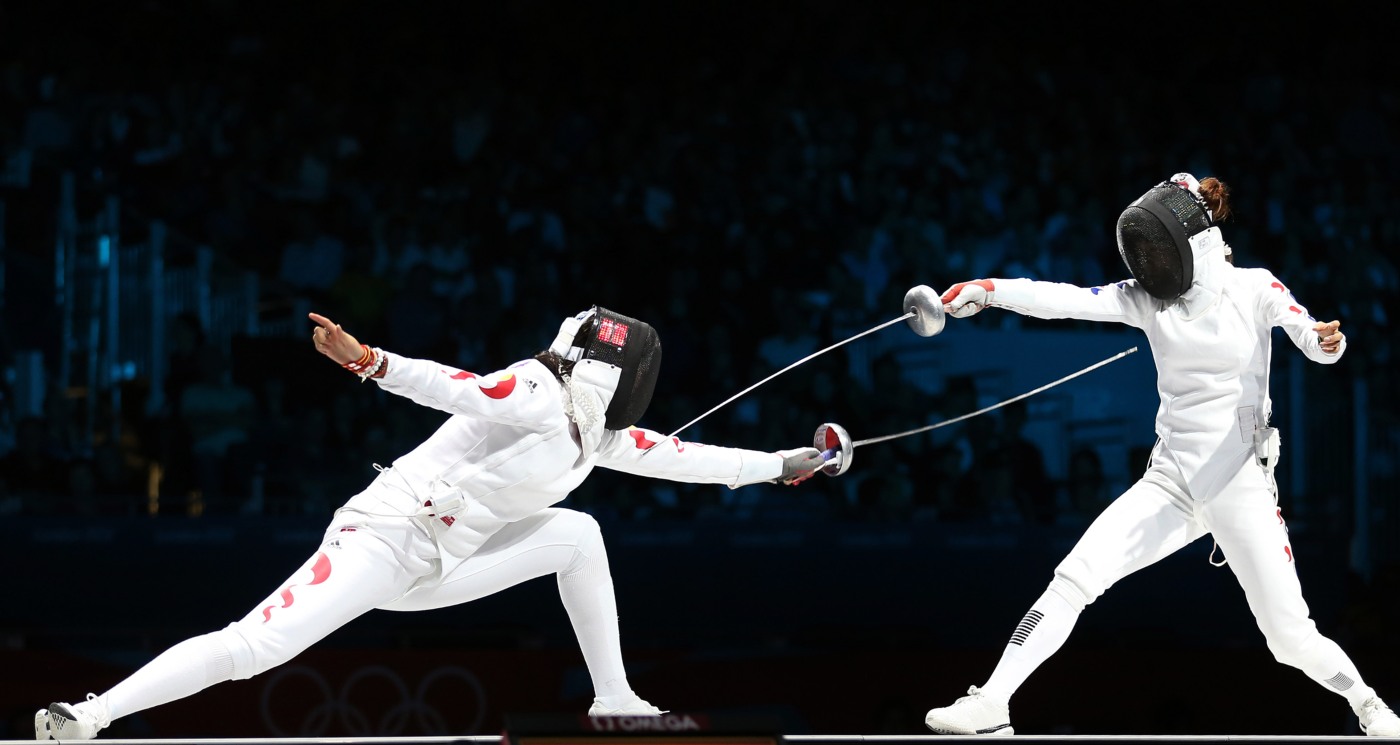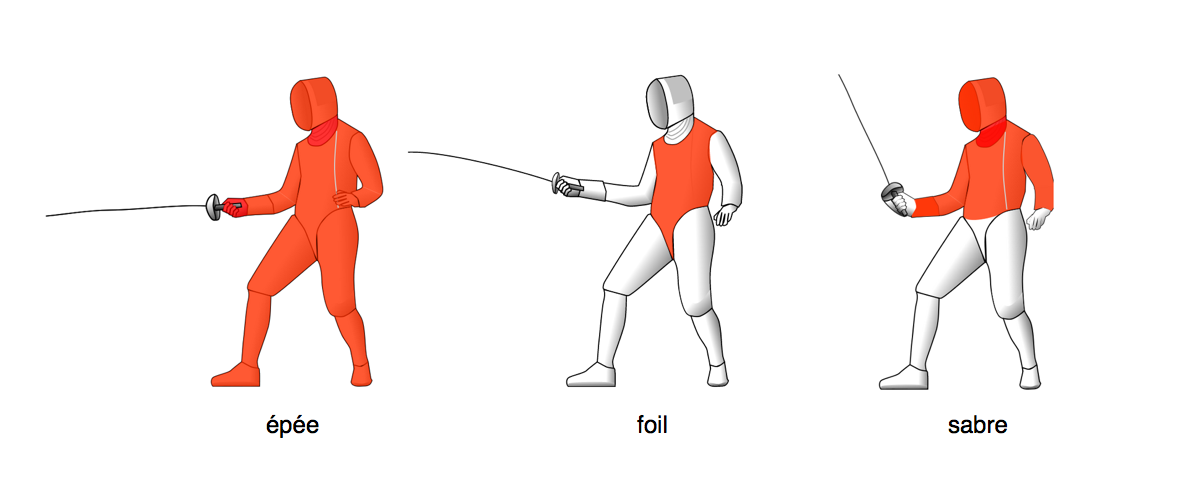Eager to find a sport that challenges your child’s body AND brain? Curious about which sport gives your child the greatest chance of continuing to participate in college or secure a scholarship? Want to find a sport that is truly open to any child, regardless of body type, mentality, or temperament? Well friends, we’re here to explain why fencing is the new it sport for kids.
“Fencing is truly unique in the way it challenges kids on every level,” says Michael Aufrichtig, who over the previous seven years has coached Columbia University’s men’s and women’s fencing teams to multiple NCAA championships.
“Aerobically, it can be very demanding – you use every part of your body. At the same time it forces kids to learn to think analytically – they need to observe, analyze, and adjust constantly, and very quickly.”

One of the modern Olympic game’s original five sports, fencing is growing in popularity thanks to:
- The success of a growing number of American fencers on the world stage
- Parents’ appreciation of the way fencing gives their kids a complete body-mind workout
- The sport’s abundance of higher education opportunities relative to other sports
- Fencing’s accessibility and openness to all types of kids
And perhaps most important of all, parents are discovering that fencing is as much art as sport, that it not only gets kids off the couch and taxes them physically, but forces them to dig deep for new modes of strategic thinking – strengths that will help them long after childhood is behind them.
“Becoming a fencer is a truly developmental process,” says Connie Shreiber, executive director of the Fencing Sports Academy. “The skills a child learns in fencing – in learning how to correctly assess what an opponent is doing and to adapt accordingly – will help them for the rest of their lives. It’s a definite confidence-builder.”
All Body Types, Genders, and Mindsets Welcomed
Old-timers may recall the classic Armour Hammer jingle about how its hot dogs were popular with every kind of kid, even those who climb on rocks or have chicken pox? Yep, that’s fencing (well, maybe not the chicken pox part).
Tall or short, heavy or lean, shy or aggressive, boy or girl, able-bodied or disabled, fencing has a place for every child. (We also should note that despite all the cool gear involved, fencing is no more expensive than most other sports. Many clubs provide gear to beginners.)
“There are all types of kids in fencing. You have super athletes, non-athletes, extroverts and introverts – any of these kids can be very good at this sport,” says Aufrichtig, who has groomed 11 fencers for the Olympic games and, perhaps most telling, has seen 116 of his fencers make the academic Dean’s List.

An introverted or timid child who isn’t necessarily drawn to team sports, for example, can thrive during his or her time on the strip (the competitive fencing area measuring 14 meters by two meters where individual bouts are fought).
Similarly, tall kids with a long reach aren’t necessarily favored over smaller children, primarily because fencing teaches kids to leverage their own unique physiologies while simultaneously taking advantage of an opponent’s. “If a child is light on his feet or especially nimble, he’ll have an advantage over a bigger, slower kid,” says Aufrichtig.
Amy Papadopoulos, owner of Loudoun International Fencing Club, thinks this body-agnosticism is one of the many reasons fencing is able to develop confidence in kids – particularly girls. “If you think about it, you’ve got an opponent who is trying to hit you with a sword,” she says. “Girls aren’t usually raised to think and act physically aggressive. So when we get them over that hurdle, they discover a new level of confidence.”
Alternatively, more extroverted or team-focused kids will find fencing to be an excellent outlet for their aggressive tendencies. Or as Race Imboden of Team USA Fencing says with a wry smile, “It’s sword fighting – and I get to sword fight every day.”
Jedi Masters Wanted
In an era when so many parents are increasingly concerned about their kids’ growing addictions to digital screens, fencing offers a compelling alternative. Boys who love video gaming, for example, will find themselves drawn to fencing’s sanctioned combat and to the sophisticated scoring system that lights up each time a blade makes contact.
“I’ve found that kids who love Star Wars or video games often love fencing,” says Aufrichtig. “What other sport hands a kid a sword and electronically scores and lights up when they make contact? It’s like playing inside your own video game.”
Wireless transmitters, conductive jackets, laser line tracking, floor lighting systems, and digital scoreboards have all been developed to work in concert and provide more precise scoring for fencers and fans alike.
While the technology is indeed cool, what kids really come to love about fencing is what they love about gaming: solving increasingly complex problems for points/scores at incredibly fast speeds.
In fencing, a child learns to gauge an opponent’s habits and personality and respond accordingly. Is she aggressive or passive or does she constantly change tempo and movement? A bad decision can instantly result in a ‘touch’ of the opponent’s blade. Similarly, the right judgment wins the point. With discipline, kids learn to mentally slow the match in their heads even as they react at full speed.
Brains Over Brawn
What truly sets fencing apart is the mental power demanded of its participants. “Thinkers,” says Papadopoulos, “often do well in fencing.”
So, what does thinking have to do with it? For starters, the fencing blade is considered the second fastest object in the Olympic games, trailing only a rifle’s bullet. This is why fencing often is described as chess – played at 100 mph.
But it’s more than that, says Schreiber. “What matters in chess is where your move starts and ends. But in fencing, speed also must be factored in, and this adds a whole new dimension.”

Also like chess, experienced fencers will tell you that there is never one way to win a match. Even as a participant is analyzing her opponent’s strategy and adapting accordingly, her opponent is responding and reacting as well. Which is why, over time, fencers become increasingly analytical in their thinking – an incredibly important skill they’ll need later in life.
The Face of Modern Fencing
Take a look at the fellow below. Two years ago Daryl Homer nabbed America’s first Olympic silver medal in fencing since 1904.
Famed for his explosive ‘flunges’ – highly athletic lunges aimed at surprising an opponent with a lightning-fast strike to the upper body – Homer started fencing at the tender age of 11 after seeing an image of a fencer and thinking he looked ‘cool.’

Since then, Homer has emerged as the nation’s second-best fencer and the poster-child for a new breed of fencer that embraces the sport’s unique combination of athleticism, speed, and aggressiveness with poise, patience, and strategy.
Thanks to Homer and, before him, Mariel Zagunis, American fencing is enjoying something of a renaissance. (Fencing is even more popular overseas. Some Chinese fencing clubs, says Aufrichtig, have more than 10,000 members.)
When to start your child at fencing? Most experts agree that there’s no perfect age to get started. Schreiber says she has seen children as young as three on the strip. “Fencing is a lifetime sport – we have people in their 70s who fence.”
Aufrichtig believes kids should play multiple sports until at least the age of 12 – something sanctioned by most child development experts – and only then decide if they wish to specialize in the sport.
College and Beyond
In a nation where parents each year spend incredible sums of money on mainstream sports (e.g. football, basketball, baseball, etc.) in the hopes their children may become good enough to secure a college scholarship, fencing actually delivers better odds – much better.
For starters, the percentage of high school athletes who go on to participate in their sport at the college level – scholarship or not – is considerably higher for both boys and girls than any other sport. We’re talking double-digit differences here.
Consider, for example, that while “the overall percentage of high school students who go from competing in a sport in high school to playing in college is just 7.6% for boys and 7.9% for girls, fencers come in at a whopping 29.6% for boys and 38.2% for girls!”
The same goes for scholarships, though girls actually fare a bit better than boys on this one. According to the NCAA, there are 43 combined D1 and D2 varsity fencing teams for girls and just 34 for men. And those D1 women’s programs offer at least 5 scholarships compared to 4.5 for men’s programs.
But even more important than playing at the college or university level is how fencing prepares kids for adult life.
“Fencing,” says Ayesha Shah, manager of Fairfax Fencers, “increases self-control and improves the way one overcomes physical and psychological obstacles in life, thus reducing stress levels.” Something that is particularly important in an era when so many young people – particularly teens – are suffering from high levels of anxiety and stress.
“If you want a sport that is going to tax your child physically, develop them mentally, and give them the confidence they’ll need later in life, I can think of no better sport than fencing,” concludes Aufrichtig.
Want to learn more about fencing? Check out the video below or, better yet, visit a local club and see for yourself!
Famous fencers: Winston Churchill, President Theodore Roosevelt, Gen. George Patton (a U.S. Olympic fencer and pentathlete), Iron Maiden lead singer Bruce Dickinson, pop singing icon Neil Diamond, and not surprisingly, ‘The Three Musketeers’ author Alexandre Dumas.

Fencing is a great sport, but if you are any good it becomes very expensive. Plan for 6 trips a year to different parts of the country for a weekend (so that’s flights and hotels and fees) and if you are really good you will do several trips a year to Europe in high school. Plus your club fees and lessons.
Consider this. The money you put into fencing as opposed to money that would be needed to support medication for high blood pressure, diabetes and other life threatening diseases and disorders. So fencing is the better alternative. fencing keeps the mind more challenged and slows the onset of dementia and other mental aging diseases. Your circulation and mobility will improve as well. you will look , act and feel years younger than your same age colleagues who sit on the recliner and their sole exercise after eating dinner and a chocolate layer cake is to hit the channel changer while burping. I started fencing almost 50 years ago in September of 1968 in High School and at the Salle Csiszar fencing club and then college and the AFLA and the USFA which is now USA Fencing. I don’t regret it for a minute.